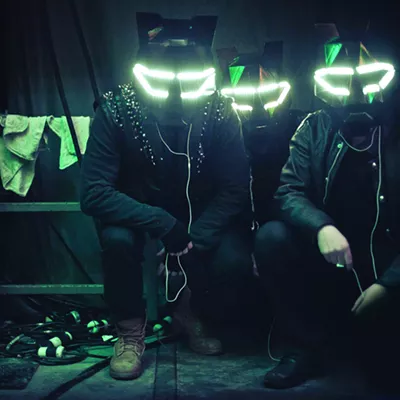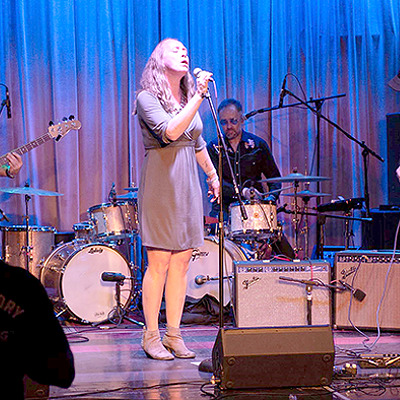"Finding shoes can be a problem," notes Medina, senior ballerina with Les Ballets Trockadero de Monte Carlo. "Some of our dancers have to have shoes made."
The reason? Medina is Fernando, not Fernanda, and he and the rest of the "ballerinas" in the company are men, with men's big feet. The trouble is that manufacturers, understandably, typically make pointe shoes in smaller sizes, for women only. Medina is lucky, though: Most of the time, he manages to squeeze his own moderate-sized tootsies into standard toe shoes.
"My size is 10, and I can get those," he reports by phone from New York, where he's rehearsing for the West Coast tour that will bring the troupe to Tucson's Centennial Hall tonight, Thursday, Jan. 31. "Some ballerinas"--meaning women--"have long feet."
Les Ballets Trockadero is a serious gag that has been running 33 years. "Serious," because the dancers, 15 strong, are top-notch, highly trained dancers. "Gag," because they're men who dress in tutus and swoon and sweep across the stage in hilarious parodies of ballet classics.
The Tucson show, for instance, will open with the eminently lampoonable Swan Lake Act II. Set to lush, familiar music by Tchaikovsky, Swan Lake is one of the best-known ballets in the repertoire. In any production, long rows of ballerinas flit around the stage like swans, swathed in swan-like tutus. Their white headdresses often look more like shower caps than feathers. In the precarious "Pas de Quatre," four swans dance on pointe, arms linked.
Ballet Trock's deadpan version satirizes this tradition. There's no Matthew Bourne reworking the choreography into newly strenuous masculine moves for his all-male cast. The Trockadero dancers remain men dancing women's parts. And they do it beautifully, and comically. One of the little swans might get her foot tangled up in another's. A stray elbow might poke another's eye. A delicate swan's black chest hair might poke over the top of her satin dress.
"In order to do a good parody, you have to know what you're doing, and love it," Medina says.
Medina is a case in point, so to speak. A native of Spain, he trained seriously in ballet. He studied first in Barcelona and then auditioned into the Madrid school of Victor Ullate, a master teacher whose students include Angel Corella, now a star of American Ballet Theatre. Medina next trained at Béjart Ballet Lausanne in Switzerland, with Maurice Béjart, the acclaimed French choreographer who died in November.
"After that, I started working in a ballet company, Basel Ballet, in Switzerland," Medina says. "That disappeared, and I went to Holland, to dance with Introdans, a Dutch company that does contemporary neo-classical."
Four years into his career, Medina decided to "make a switch."
"Trockadero just crossed my path," he remembers. "I was on holiday in Madrid. They were touring. I loved the show."
He was enchanted both by the dancing and the comedy.
"They have ballet going on. The humor was sensational. A real clown that I am, I auditioned and joined the company in 1998."
Medina, 36, has been a Trock ever since. "I'm having fun. Once it gets you, it's difficult to leave. I'm happy with what I'm doing."
In Tucson, he'll dance the female lead in a classic pas de deux, possibly from Don Quixote. Also on the bill is the legendary Grand Pas de Quatre, a 19th-century chestnut composed for four of the day's leading ballerinas.
"It's a very beautiful piece. We pretend to be the great ballerinas. It's really cute and funny. We have a lot of rivalry between the women."
The grand finale is a new work choreographed by company dancer Raffaele Morra. Featuring 14 of the company's international cast of 15 dancers--they hail from Italy, Germany, Israel, Australia, the United States, Puerto Rico and Spain--the piece is inspired by the Ballet Nacional de Cuba. It's called Majisimas, which Medina translates as "very pretty girls."
'Nuff said.
ighty Russian folk dancers take to the Centennial Hall stage just four nights after the putative ballerinas depart. Moiseyev Dance Company, founded in 1936 under the auspices of the Soviet Union, performs a panoply of energetic dances drawn from the 180 different cultures that made up the old union.
But as many critics have noted during the troupe's history, the dancers are not rustics, and the colorful choreography doesn't spring fully formed from the genius of the people. In fact, like Les Ballets Trockadero, the Moiseyev has ballet roots.
The company's founder and chief choreographer, Igor Moiseyev, was a ballet sophisticate who danced for 15 years with the esteemed Bolshoi Ballet, and later was ballet master and choreographer for the troupe. In his student days, so the story goes, he had wandered the countryside studying folkloric song and dance. When he started his eponymous folk company, he merged the two forms by insisting that his dancers master ballet.
At his death at the age of 101 in November 2007, his New York Times obituary recalled that he once called ballet "the grammar of movement." He told a reporter, "With ballet technique as a base, one can do everything."
But Moiseyev's fusion of the two forms earned him a footnote in political history. The Moiseyev helped thaw Soviet-American relations by dancing in America during the Cold War, the first Soviet troupe to do so. The high-kicking Russian dancers won over the New York critics, and even endeared themselves to Middle America with an hour-long performance on the Ed Sullivan Show in 1958. Fifty years later, they're still making their leaps.














